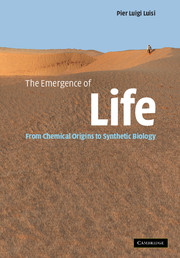Book contents
- Frontmatter
- Contents
- Preface
- Acknowledgments
- List of books on the origin of life
- 1 Conceptual framework of research on the origin of life on Earth
- 2 Approaches to the definitions of life
- 3 Selection in prebiotic chemistry: why this … and not that?
- 4 The bottle neck: macromolecular sequences
- 5 Self-organization
- 6 The notion of emergence
- 7 Self-replication and self-reproduction
- 8 Autopoiesis: the logic of cellular life
- 9 Compartments
- 10 Reactivity and transformation of vesicles
- 11 Approaches to the minimal cell
- Outlook
- References
- Index
9 - Compartments
Published online by Cambridge University Press: 17 December 2010
- Frontmatter
- Contents
- Preface
- Acknowledgments
- List of books on the origin of life
- 1 Conceptual framework of research on the origin of life on Earth
- 2 Approaches to the definitions of life
- 3 Selection in prebiotic chemistry: why this … and not that?
- 4 The bottle neck: macromolecular sequences
- 5 Self-organization
- 6 The notion of emergence
- 7 Self-replication and self-reproduction
- 8 Autopoiesis: the logic of cellular life
- 9 Compartments
- 10 Reactivity and transformation of vesicles
- 11 Approaches to the minimal cell
- Outlook
- References
- Index
Summary
Introduction
The following chapters are rather technical, in contrast to most of the previous ones, which have been more discursive. As already mentioned, this reflects the dual nature of the field of the origin of life, which is based both on the “software” of epistemological concepts, and on the hardware of organic and physical chemistry.
We are approaching the final part of the book, concerned with cellular models based on vesicles. The main keywords are now “compartment” and (if this word exists) “compartmentation.” The biological potential of these aggregates is closely related to their physical properties, and for this reason some of these basic characteristics will first be briefly considered. Also, to give a proper background to these properties, it may be useful to compare various kinds of compartments, such as micelles, reverse micelles, cubic phases, and vesicles. This will be useful to understand better biochemical reactions in vesicles, which will be dealt with in the next chapter.
Surfactant aggregates
We have already seen in Chapter 5, on self-organization, how and why amphiphilic molecules tend to form aggregates such as micelles, vesicles, and other organized structures.
Figure 9.1 illustrates again this general phenomenon, emphasizing that for a given surfactant the type of aggregate formed is determined by the corresponding phase diagram, namely by the relative concentration of the three (in this case) components.
- Type
- Chapter
- Information
- The Emergence of LifeFrom Chemical Origins to Synthetic Biology, pp. 182 - 213Publisher: Cambridge University PressPrint publication year: 2006
- 1
- Cited by



